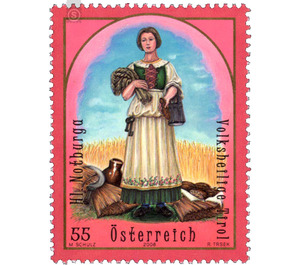patrons - Austria / II. Republic of Austria 2008 - 55 Euro Cent
Theme: Religion & Spirituality
| Country | Austria / II. Republic of Austria |
| Issue Date | 2008 |
| Face Value | 55.00 |
| Edition Issued | 500,000 |
| Printing Type | combination printing |
| Stamp Type | Commemorative |
| Item Type | Stamp |
| Chronological Issue Number | 2089 |
| Chronological Chapter | OOS-OE2 |
| SID | 573410 |
| In 55 Wishlists | |
Notburga is one of the most revered saints in Tyrol. There is hardly any historical data about her life. In the 17th century, a biography based on the legends was written by the Haller physician Hippolyt Guarinoni. Notburga was a typical figure of the late Middle Ages, lived half a century after St. Francis and St. Elizabeth of Thyringen, whose advocacy for the poor had brought about a new movement in the Middle Ages. Notburga - not a nobleman, not a nun but a simple woman of the people - served as a great role model especially in the Tyrol. Legend has it that Notburga was born around 1265 in Rattenberg. She worked as a maid at Rottenburg Castle and cared as a young girl for the poor and sick. With the approval of the count's family, she distributed the remains of the food to the needy. After the death of the employer, the young countess displeased the social commitment of Notburga and drove her away from the Rottenburg. Norburga found in the nearby community Eben am Achensee a job as a peasant maid. In the meantime, misfortune came over Castle Rottenburg, the lady of the castle died and the young count fell into quarrel with his brother. In this situation, he remembered the maid Notburga and brought her back to the castle. Notburga established peace between the brothers and was allowed to resume the caring care of the poor and the sick. After her death in 1313, she was buried in front of the altar of the Rupertikirche in Eben. The veneration of the devout maid quickly spread to Tyrol and Bavaria, and Notburga's grave became a popular pilgrimage site. In 1434, the small church was rebuilt into the Notburgakirche in Eben. The veneration of Notburga received in 1862 the official confirmation by Pope Pius IX. The festival of Tyrolean folk saints is celebrated on 13th September. On this day, the solemn Notburg procession takes place in Eben am Achensee. Notburga is the patron saint of servants, the poor and the peasants. She is also considered the protector of Sunday rest. It is presented with a cereal, a sickle and a pitcher. They point to the legendary wreath that surrounds Notburga. For example, one tells of the "wood chip miracle": When Notburga once again brought food and drink to the poor, she was questioned by the count, but in her apron and in the jug were only wood chips and lye. Well-known, however, is the "sickle-miracle". The farmer, to whom Notburga had made a claim, demanded from her and the servants that work continued after the closing time and that the grain should be cut. Notburga threw her sickle at the sky and turned to prayer. The sickle remained suspended above her head like a sunbeam suspended in the air.


